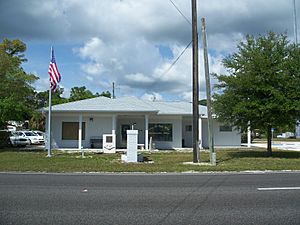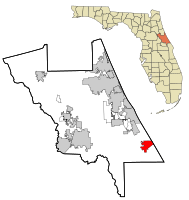Oak Hill, Florida facts for kids
Quick facts for kids
Oak Hill, Florida
|
|
|---|---|

Oak Hill City Hall
|
|
| Motto(s):
"Where We Make Fishers of Many"
|
|

Location in Volusia County and the state of Florida
|
|
| Country | |
| State | |
| County | Volusia |
| Settled | 1857-1874 |
| Incorporated (Town of Oak Hill) |
1925 |
| Incorporated (City of Oak Hill) |
1927 |
| Government | |
| • Type | Mayor–Commission |
| Area | |
| • Total | 11.19 sq mi (28.98 km2) |
| • Land | 6.72 sq mi (17.40 km2) |
| • Water | 4.47 sq mi (11.58 km2) |
| Elevation | 13 ft (4 m) |
| Population
(2020)
|
|
| • Total | 1,986 |
| • Density | 295.54/sq mi (114.11/km2) |
| Time zone | UTC-5 (Eastern (EST)) |
| • Summer (DST) | UTC-4 (EDT) |
| ZIP code |
32759
|
| Area code(s) | 386 |
| FIPS code | 12-50450 |
| GNIS feature ID | 0287965 |
| Website | www.oakhillfl.com |
Oak Hill is a small city located in Volusia County, Florida, in the United States. It is part of a larger metropolitan area that includes cities like Deltona and Daytona Beach. In 2020, about 1,986 people lived in Oak Hill. The city's motto is "Where We Make Fishers of Many," which hints at its connection to fishing and the water.
Contents
History of Oak Hill
The area where Oak Hill now stands was first home to the Timucua people. They lived along the coast from around 2000 BCE until European settlers started arriving in the 1500s. A French artist named Jacques LeMoyne even drew a map in 1564 showing a Native American village nearby. The name "Oak Hill" probably came from loggers from the north around 1850.
Early Settlers and the Civil War
Florida became a state in 1845. Soon after, British and American settlers began to move in. This led to conflicts with Native American tribes, including the Seminoles. In 1856, a Seminole War raid caused four deaths. People started settling permanently in the area between 1857 and 1874.
By the time of the American Civil War, Oak Hill had a salt works and some small stores. The first orange groves were also planted here. The local cemetery is home to Civil War veterans, both those who fought for the Union and those who fought for the Confederacy.
Schools and Community Growth
Over time, Oak Hill grew to include hotels, more stores, a post office, and schools. Early schools included one run by a church for both white and Black students. Later, separate public schools were built for white students in the 1890s and for Black students in 1927.
In 1924, a new school for grades 1 through 10 was built. This building was replaced in 1960 by what became the W.F. Burns Elementary School. In 2008, the school board decided to close it due to budget cuts.
However, the community didn't give up! A non-profit group called the Oak Hill Community Trust bought the property in 2009. Many volunteers worked thousands of hours to fix up the buildings. They did everything from plumbing to painting, often using donated materials. The school reopened in August 2011 with 260 students.
In 2012, the Kennedy Space Center gave the school a large office building. Volunteers again helped move and rebuild it into new classrooms. Today, the school is a STEM (Science, Technology, Engineering, Math) school. It has earned an "A" rating and serves 1,100 students from kindergarten to 12th grade.
Economy and Recreation
In the past, growing citrus fruits and commercial fishing were the main ways people in Oak Hill made money. However, cold weather and a plant disease called citrus canker greatly reduced the orange groves. Also, a state law in 1995 limited most fishing businesses. Today, there are still some fish, clam, and oyster farms.
Now, recreational fishing and eco-tourism are very popular. Oak Hill is a starting point for the Florida "River of Lakes" scenic highway. Many bicycle paths also go through the city, so you'll often see groups of cyclists. East of the city center, you can find the Seminole Rest National Historic Site, which is part of the Canaveral National Seashore.
City Government and Future Growth
Oak Hill was first officially made a town in 1925 and then a city in 1927. The city government works to make it easy for businesses to open and operate. For example, business owners over 65 can get or renew their city licenses for free.
The city government was briefly inactive in the 1930s during the Great Depression. It was reactivated in 1962. Clarence Goodrich was the mayor for a very long time, from 1963 to 1989. Toreatha Wood became the city's first female mayor and first African-American female mayor in 1999. The current mayor, Douglas Gibson, was elected in 2012.
In 2011, the city decided to change its police department due to disagreements. The Volusia County Sheriff's Department now handles law enforcement for the city.
Oak Hill is expecting a lot of growth soon. Several new housing developments are being planned. These could add about 1,400 new homes, possibly doubling the city's population in the next five years. The city has paused new applications for a year to prepare for this growth.
One of the new developments includes two historic Black cemeteries, known as "Saints and Sinners." The developer and community groups are working together to make sure these cemeteries are cared for.
Geography
Oak Hill covers a total area of about 28.98 square kilometers (11.19 square miles). A large part of this area, about 11.58 square kilometers (4.47 square miles), is water.
Climate
The weather in Oak Hill is usually warm. Summers are hot and humid, while winters are generally mild. This type of weather is known as a humid subtropical climate.
Population and Demographics
Demographics is the study of a population, looking at things like age, race, and how many people live in an area.
| Historical population | |||
|---|---|---|---|
| Census | Pop. | %± | |
| 1930 | 457 | — | |
| 1940 | 509 | 11.4% | |
| 1950 | 683 | 34.2% | |
| 1960 | 758 | 11.0% | |
| 1970 | 747 | −1.5% | |
| 1980 | 938 | 25.6% | |
| 1990 | 917 | −2.2% | |
| 2000 | 1,378 | 50.3% | |
| 2010 | 1,792 | 30.0% | |
| 2020 | 1,986 | 10.8% | |
| U.S. Decennial Census | |||
Population Changes (2010 and 2020)
The table below shows the different groups of people living in Oak Hill based on the 2010 and 2020 United States censuses. It helps us see how the population has changed over time.
| Race | Pop 2010 | Pop 2020 | % 2010 | % 2020 |
|---|---|---|---|---|
| White (NH) | 1,467 | 1,667 | 81.86% | 83.94% |
| Black or African American (NH) | 249 | 187 | 13.90% | 9.42% |
| Native American or Alaska Native (NH) | 8 | 5 | 0.45% | 0.25% |
| Asian (NH) | 9 | 12 | 0.50% | 0.60% |
| Pacific Islander or Native Hawaiian (NH) | 0 | 1 | 0.00% | 0.05% |
| Some other race (NH) | 0 | 5 | 0.00% | 0.25% |
| Two or more races/Multiracial (NH) | 28 | 67 | 1.56% | 3.37% |
| Hispanic or Latino (any race) | 31 | 42 | 1.73% | 2.11% |
| Total | 1,792 | 1,986 |
In 2020, there were 1,986 people living in Oak Hill. These people lived in 817 households, and 604 of these were families. In 2010, there were 1,792 people, 757 households, and 581 families.
See also
 In Spanish: Oak Hill (Florida) para niños
In Spanish: Oak Hill (Florida) para niños

